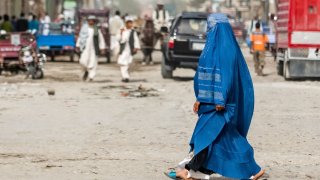Inside the Taliban’s Afghanistan
The truth about life in Afghanistan after 2021 is more complex than conventionally understood.
On either side of the tunnel, trucks, buses, taxis, and private cars have to drive for hours on a broken track. On one of our visits, the authorities had forbidden trucks to pass through, as the heavy rain of the previous days had turned some sections into a quagmire. We estimated that between 1,500 and 2,000 vehicles were blocked on either side of the tunnel. Some had to wait more than a week to get through. How can we envisage national integration, let alone regional integration between Central and South Asia, under such conditions?
We mentioned above the low level of mechanization in the agricultural sector. Paradoxically, this is undoubtedly an advantage for today’s Afghanistan, as it enables the economy to absorb the growing number of young people. It is those under the age of twenty-five who account for 63 percent of the Afghan population. These young Afghan generations are also the ones who make up the multitude of school children seen along the roads, all carrying the same UNICEF backpack. When we came across them, two things struck us. First, the number of schools seems insufficient. We saw schoolchildren walking many kilometers to get to the nearest school. Second, the number of schoolgirls seems to be just as high as the number of schoolboys. This undermines conservative rhetoric that justifies the ban on secondary and university schooling for women on the basis that families do not want education for their girls.
Lastly, there were our experiences with the authorities (Afghan hospitality has always been and remains an essential marker of the relationship with “foreigners”). We encountered a wide range of attitudes during our exchanges with the Taliban in the provinces. Their first reaction was astonishment since, as we mentioned earlier, there are very few foreigners on the Afghan roads. We also felt coldness on the part of some of the authorities. In many ways, this coldness is understandable since we represent the West, which they had been fighting for years in a war in which they had lost friends and family members. There was also a great deal of curiosity, with the eternal questions about our country of origin, the reasons for our presence in Afghanistan, and sometimes about our religion, a subject close to the heart of many Afghans for whom atheism is inconceivable.
As for relations between Afghan civilians and the Taliban, from what we could perceive, they range from a certain form of acceptance to feigned or deliberate ignorance. The most determined opponents are clearly not so easily discovered in the current context of omnipresent surveillance. Who can really appreciate what Afghans, and especially Afghan women, really think? Here, too, there are undoubtedly major differences between Afghan women in rural areas who appreciate the end of the war and educated women in Kabul who, under the Republic, benefited from new opportunities.
On June 30 and July 1, representatives of the international community and the Islamic Emirate of Afghanistan finally met around the same table in Doha under the aegis of the United Nations. The diplomats present also had the opportunity to meet a small group of Afghan men and women, the majority of whom live and work in Afghanistan. Let us hope that this first meeting will be followed by similar meetings that will pave the way toward constructive dialogue and lead to a better understanding of the reality and aspirations of Afghanistan today. Let us also hope that this process will quickly lead to a situation that will give all Afghans the political space and resources they need to build their common future together in a peaceful manner.
Jean-François Cautain, a former European Union Ambassador, has worked in Afghanistan at various times since 1986, first as an NGO director and then as a diplomat for the European Union.
Sonia Cautain has worked on several occasions in Afghanistan since 1994 with non-governmental organizations (NGOs). Until last April, she was head of mission for a medical NGO in Kabul.
Image: 279 Photo Studio / Shutterstock.com.

